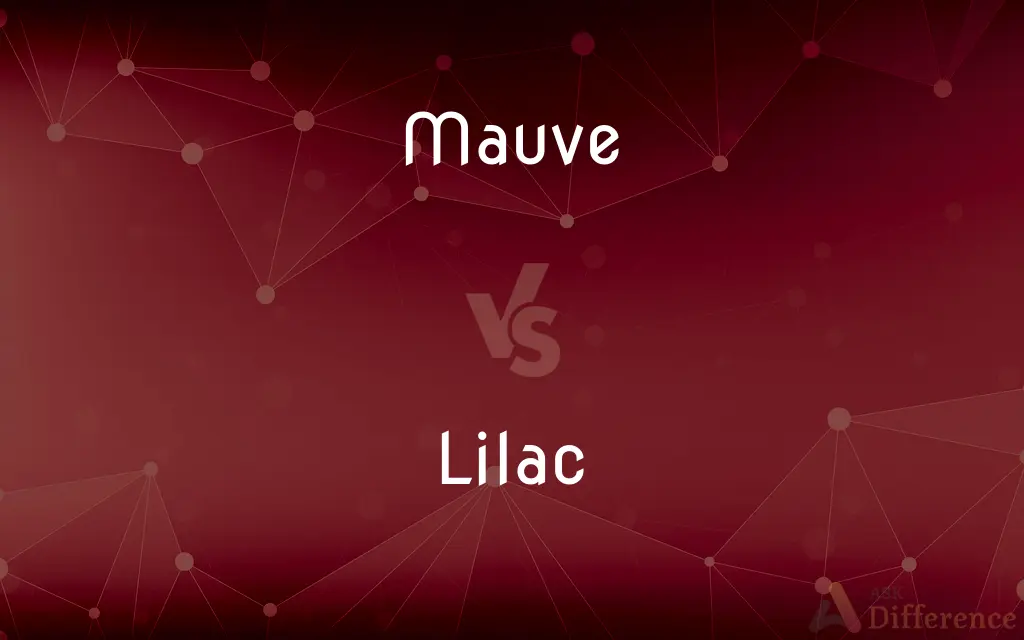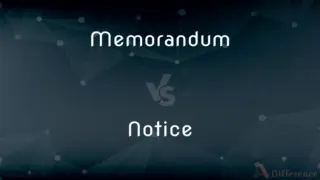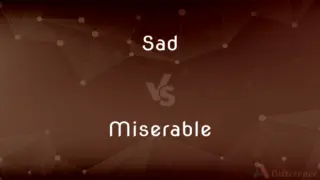Mauve vs. Lilac — What's the Difference?
By Urooj Arif & Maham Liaqat — Updated on April 8, 2024
Mauve is a pale purple color with more gray and blue tones, suggesting a subdued elegance, while lilac is a lighter purple that evokes springtime freshness and youthfulness.

Difference Between Mauve and Lilac
Table of Contents
ADVERTISEMENT
Key Differences
Mauve, characterized by its subtle and somewhat grayish purple hue, leans towards a cooler and more understated elegance, often associated with maturity and sophistication. This color can be seen as versatile, fitting both solemn and casual contexts due to its muted nature. On the other hand, lilac, with its brighter and lighter shade, exudes a more vibrant and youthful energy, reminiscent of early spring. It is often used to signify innocence and new beginnings, making it a popular choice in floral arrangements and festive decor.
Mauve has historical significance that dates back to the 1850s when it was first synthesized as a dye, symbolizing innovation and the dawn of synthetic colors in fashion. This color has since been associated with both Victorian opulence and the subtle elegance of modern design. Whereas lilac's significance is deeply rooted in nature and symbolizes first love in the language of flowers, it carries a sense of nostalgia and romance, often used in events that celebrate beginnings and youthful joy.
In terms of color psychology, mauve is thought to promote feelings of calm and composure, often used in interior design to create a serene and sophisticated atmosphere. It’s seen as a mature, refined color that balances between red’s warmth and blue’s coolness. Lilac, however, is believed to stimulate creativity and youthfulness, making it a preferred choice for spaces intended to inspire energy and innovation. Its presence in a room can brighten the mood and foster a welcoming, playful environment.
The application of mauve in fashion and design is typically seen in more formal and elegant contexts, such as evening wear, luxury branding, and minimalist decor. It's a color that conveys a sense of refined taste and understated luxury. Lilac, on the contrast, is more frequently used in spring and summer collections, children's products, and whimsical designs, highlighting its association with freshness, vitality, and playfulness.
While both colors are derived from purple, their differing intensities and tones lead to varied uses and symbolisms. Mauve, with its subdued and cooler tones, is often preferred in settings that aim for a sophisticated and calming ambiance. Lilac, with its lighter and warmer hues, finds its place in more vibrant and youthful contexts, bringing a sense of renewal and excitement.
ADVERTISEMENT
Comparison Chart
Hue
Subdued, grayish-purple
Bright, light purple
Symbolism
Elegance, sophistication, innovation
Freshness, youthfulness, first love
Historical Significance
First synthetic dye color, Victorian era
Nature, spring, romance
Color Psychology
Calm, composure, refinement
Creativity, energy, playfulness
Common Uses
Formal wear, luxury branding, minimalist decor
Spring/summer collections, children's products
Compare with Definitions
Mauve
A pale purple color with gray and blue tones.
The bridesmaids wore elegant mauve dresses.
Lilac
A light purple color that evokes the freshness of spring.
The garden was filled with the beautiful scent of lilac blooms.
Mauve
Associated with the dawn of synthetic dyes.
Mauve became popular in the 19th century due to its synthetic origin.
Lilac
Associated with playfulness and vitality.
The lilac-colored accessories added a playful touch to her outfit.
Mauve
Reflects a balance between warmth and coolness.
The mauve wallpaper struck the perfect balance in the living room’s color scheme.
Lilac
Symbolizes first love in the language of flowers.
He gave her a bouquet of lilacs to signify his first love.
Mauve
Ideal for creating a serene atmosphere.
The designer used mauve tones to ensure the bedroom felt peaceful.
Lilac
Represents innocence and new beginnings.
Lilac themes are popular for spring weddings.
Mauve
Symbolizing sophistication and understated elegance.
The mauve accents in the room added a touch of sophistication.
Lilac
Fosters creativity and youthful energy.
The children’s playroom was painted in vibrant lilac.
Mauve
Mauve ( (listen), mohv; (listen), mawv) is a pale purple color named after the mallow flower (French: mauve). The first use of the word mauve as a color was in 1796–98 according to the Oxford English Dictionary, but its use seems to have been rare before 1859.
Lilac
A Eurasian shrub or small tree of the olive family, which has fragrant violet, pink, or white blossom and is a popular garden ornamental.
Mauve
Of a pale purple colour
Blossoms with mauve and white petals
Lilac
Any of various shrubs of the genus Syringa, especially S. vulgaris, which has been widely cultivated for its clusters of fragrant flowers that are usually purplish or white but may be pink, blue, or creamy yellow depending on the cultivar.
Mauve
A pale purple colour
A few pale streaks of mauve were all that remained of the sunset
Glowing with soft pastel mauves and pinks
Lilac
A pale to light or moderate purple.
Mauve
A pale purple aniline dye prepared by William H. Perkin in 1856. It was the first synthetic dyestuff.
Lilac
A large shrub of the genus Syringa, especially Syringa vulgaris, bearing white, pale-pink, or purple flowers.
Mauve
A moderate grayish violet to reddish purple.
Lilac
A flower of the lilac shrub.
Mauve
(historical) A bright purple synthetic dye.
Lilac
(color) A pale purple color, the color of some lilac flowers.
Mauve
The colour of this dye; a pale purple or violet colour.
Lilac
Having a pale purple colour.
Mauve
Having a pale purple colour.
Lilac
A shrub of the genus Syringa. There are six species, natives of Europe and Asia. Syringa vulgaris, the common lilac, and Syringa Persica, the Persian lilac, are frequently cultivated for the fragrance and beauty of their purplish or white flowers. In the British colonies various other shrubs have this name.
Mauve
A color of a delicate purple, violet, or lilac.
Lilac
A light purplish color like that of the flower of the purplish lilac.
Mauve
A moderate purple
Lilac
Any of various plants of the genus Syringa having large panicles of usually fragrant flowers
Mauve
Of a pale to moderate grayish violet color
Lilac
Of a pale purple color
Common Curiosities
Are mauve and lilac warm or cool colors?
Mauve is considered a cooler shade due to its gray undertones, whereas lilac, with its pinkish hue, leans towards warmer.
What seasons are mauve and lilac most associated with?
Mauve is versatile for all seasons, leaning towards autumn and winter, while lilac is more spring and summer.
What colors make up mauve and lilac?
Mauve is made by adding gray to purple, while lilac is achieved by mixing white with purple.
Can mauve and lilac be used interchangeably in design?
While both can complement each other, they serve different moods and settings; mauve for elegance and lilac for vibrancy.
Can both mauve and lilac be considered feminine colors?
Traditionally, yes, but modern perspectives view all colors as versatile and gender-neutral.
Which color is more popular in fashion?
Both are popular, but lilac tends to be more prevalent in spring and summer collections.
What emotions do mauve and lilac evoke?
Mauve evokes calmness and sophistication, while lilac brings happiness and a sense of new beginnings.
How do mauve and lilac affect mood in interior design?
Mauve creates a calming and sophisticated space, while lilac adds energy and stimulates creativity.
How do lighting conditions affect the appearance of mauve and lilac?
Mauve may appear more gray or blue under certain lights, while lilac can look brighter or more muted.
How are mauve and lilac used in branding?
Mauve for luxury and sophistication; lilac for freshness, energy, and youth-oriented brands.
What are the best complementary colors for mauve and lilac?
For mauve, olive green and navy blue; for lilac, soft yellow and mint green.
Are there any cultural significances associated with mauve and lilac?
Mauve signifies innovation due to its synthetic dye origins; lilac is often linked to love and renewal in many cultures.
How do mauve and lilac relate to vintage and modern design?
Mauve is often associated with vintage elegance, while lilac fits both modern and youthful designs.
What kind of flowers come in mauve and lilac colors?
Roses, lilacs, and irises can be found in both colors, varying in shades.
Share Your Discovery

Previous Comparison
Memorandum vs. Notice
Next Comparison
Sad vs. MiserableAuthor Spotlight
Written by
Urooj ArifUrooj is a skilled content writer at Ask Difference, known for her exceptional ability to simplify complex topics into engaging and informative content. With a passion for research and a flair for clear, concise writing, she consistently delivers articles that resonate with our diverse audience.
Co-written by
Maham Liaqat













































